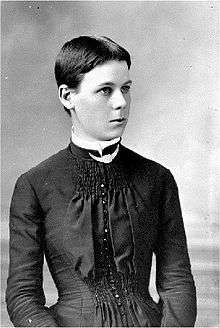Agnes Deans Cameron
| Agnes Deans Cameron | |
|---|---|
 Agnes Deans Cameron, c. 1885 | |
| Born |
20 December 1863[1] Victoria, British Columbia[1] |
| Died |
13 May 1912 Victoria, British Columbia |
| Nationality | Canadian |
| Occupation |
writer journalist lecturer educator adventurer |
| Organization |
Institute of Journalists (1910-) Western Canada Immigration Association Canadian Women’s Press Club |
| Known for | journalism, social activism, her published book and lectures as the first woman to reach the Arctic Ocean |
| Religion | Presbyterian |
| Parent(s) |
Jessie Anderson Duncan Cameron |
Agnes Deans Cameron (20 December 1863 – 13 May 1912) was a Canadian educator, writer, journalist, lecturer, and adventurer. She was the first white woman to reach the Arctic Ocean and her published book about the journey was a best-seller. She promoted immigration to Canada through her lectures and publications.
Early life
Agnes Deans Cameron was born in Victoria, British Columbia, the youngest child of Duncan and Jessie Cameron. Duncan Cameron was a successful Scots immigrant miner and contractor. She was an outstanding student at Victoria High School, a public school. While still a student she successfully wrote the provincial teachers’ examinations. She taught in the one-room school in Comox in 1882 and then returned to Victoria in 1883 to teach at the private Angela College for girls. By 1894 she was already principal of the South Park School. She was the first woman to hold an administrative office in a co-educational school in Victoria.[1]
The New North: First white woman in Arctic
In 1908 after twenty five years of teaching, Agnes Cameron accepted a contract with Western Canada Immigration Association based in Chicago. Accompanied by her niece Jessie Brown, and taking with her, her ever-present typewriter and Kodak camera,[2] they set out on a 10,000-mile round trip to the Arctic Ocean, the first white women to do so. They traveled by train from Chicago, through Winnipeg and Calgary to Edmonton, then took a stagecoach to Athabasca Landing, then they traveled by Hudson's Bay Company fur brigade scows, down the Athabasca River, across Lake Athabasca, to the Slave River, Slave Lake, the Mackenzie River to the Arctic Ocean. On their return journey with a slightly different route to include the Peace River (where Agnes shot a moose) and also a steamboat's first voyage on the Slave Lake. Based on this adventure Agnes published her book[3] entitled "The New North".[1][2]
Agnes traveled extensively as lecturer magic lantern slides of her photographic images from this journey. She promoted immigration to western Canada at Oxford, Cambridge, St. Andrew’s University and the Royal Geographical Society.[4] Her photographs were reproduced in 2011-2012 in an exhibit at the Canadian Museum of Civilization in Ottawa, Canada.[5]
Athabasca
She was particularly enthusiastic about the Athabasca region and the Athabasca oil sands which included photos of Count Alfred Von Hammerstein's oil drill works along the Athabasca River. "While the Count was unsuccessful drilling for "elephant pools of oil," Cameron’s book and its images became a best seller and made her a media celebrity."[5]
In all Canada there is no more interesting stretch of waterway than that upon which we are entering. An earth-movement here has created a line of fault clearly visible for seventy or eighty miles along the river-bank, out of which oil oozes at frequent intervals. […] Tar there is […] in plenty. […] It oozes from every fissure, and into some bituminous tar well we can poke a twenty-foot pole and find no resistance.[3][5]
References
- 1 2 3 4 Hale, Linda L. (1998). "Agnes Deans Cameron". Dictionary of Canadian Biographies. Volume XIV (1911-1920). =University of Toronto/Laval University. Retrieved July 16, 2015.
- 1 2 Holmlund, Mona; Youngberg, Gail, eds. (2003). Inspiring Women: A Celebration of Herstory. Coteau Books. p. 25. ISBN 1-55050-204-2. Retrieved July 16, 2015.
- 1 2 Cameron, Agnes Deans (1909). The New North: Being Some Account of a Woman’s Journey through Canada to the Arctic. New York: D. Appleton. Retrieved July 16, 2015.
- ↑ "Cameron, Agnes Deans (1863-1912)". ABC Book World. Retrieved July 16, 2015.
- 1 2 3 Gismondi, Mike; Davidson, Debra J. (September 2012). "Imagining the Tar Sands: 1880 -1967 and Beyond" (PDF). Imaginations. Edmonton, Alberta: Campus Saint-Jean, University of Alberta (3-2): 68–102.
Further reading
- Cameron, Agnes Deans (1909). The New North: Being Some Account of a Woman’s Journey through Canada to the Arctic. New York: Appleton.
- St Andrew's Presbyterian Church in the Heart of Victoria's Victoria. "Agnes Deans Cameron 1863-1912". University of Victoria.
- Mona Holmlund; Gail Youngberg, eds. (2003). Inspiring Women: A Celebration of Herstory. Coteau Books. p. 25.
External links
- Works by Agnes Deans Cameron at Project Gutenberg
- Works by or about Agnes Deans Cameron at Internet Archive